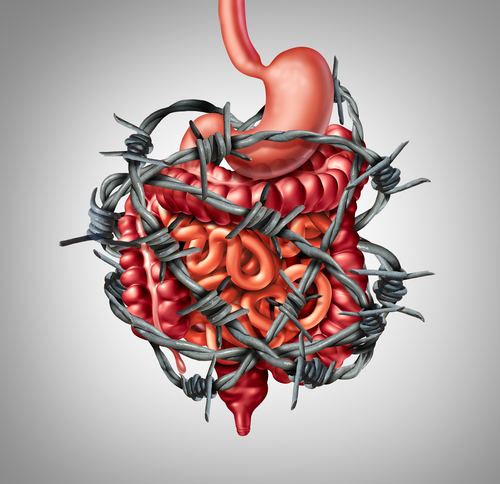Constipation is defined as having a bowel movement fewer than three times per week. With constipation stools are usually hard, dry, small in size, and difficult to eliminate. Some people who are constipated find it painful to have a bowel movement and often experience straining, bloating, and the sensation of a full bowel.
Constipation is a symptom, not a disease. Almost everyone experiences constipation at some point in their life, and a poor diet or lack of exercise typically is the cause. Most constipation is temporary and not serious. Lifestyle changes will help relieve symptoms and help prevent them from recurring. These changes may include adding high-fiber foods to the diet, drinking enough water and other liquids, such as fruit and vegetable juices and clear soups, so as not to become dehydrated and engaging in daily exercise. When this fails to offer relief, the problem may be related to nervous system interference by way of a spinal misalignment.
Muscles in the intestine push the stool to the anus, where the stool leaves the body. Special nerve cells in the intestine, called ganglion cells, make the muscles push. These nerves connect directly to the celiac ganglion, which also innervates the stomach, liver, gallbladder, spleen, kidney, small intestine, and the ascending and transverse colon. The celiac ganglion, in turn connects to the spinal cord (and the brain) through nerve roots that exit the spine in the lower thoracic and upper lumbar region.
Pressure on these nerve roots (caused by misalignment of the vertebrae in this area) may interfere with the normal function of the bowel as well as other organs of the digestive system.
The vertebral misalignments in this area of the spine are compensatory due to the initial misalignment at the apex of the spine, a vertebral subluxation of the atlas (C1) vertebra. When a subluxation occurs at C1, C2 will compensate, as will C3, C4, and so and so forth down to the pelvis. This will result in an overall body imbalance giving one the appearance of poor posture, such as one shoulder higher than the other, slight head tilt, pelvic tilt, imbalance of leg lengths, etc.
Another effect of an atlas subluxation is the resulting stress, tension, and or pressure on the spinal nerves near the brain stem. This will cause the interruption to the flow of communication from the nervous system to the rest of the body, including muscles, blood vessels, organs and organ systems. In this case, the small and large intestines, as well as the remainder of of the digestive system are susceptible to nervous system interference.
It is quite common for patients to get up and make a trip to the rest room after their first upper cervical adjustment, whether it’s immediately following the adjustment or after the resting period.
One of my patients suffered from a very bad case of constipation (in this case no more than three times in a two week period), and once the atlas was adjusted, this person began having bowel movements two to three times per day… simply from removing the interference to the nervous system.
If you or someone you know suffer from constipation, get into a chiropractor’s office ASAP and get your nervous system checked. If you live in Maricopa, click here to contact Dr. Harshe to schedule your first appointment!











